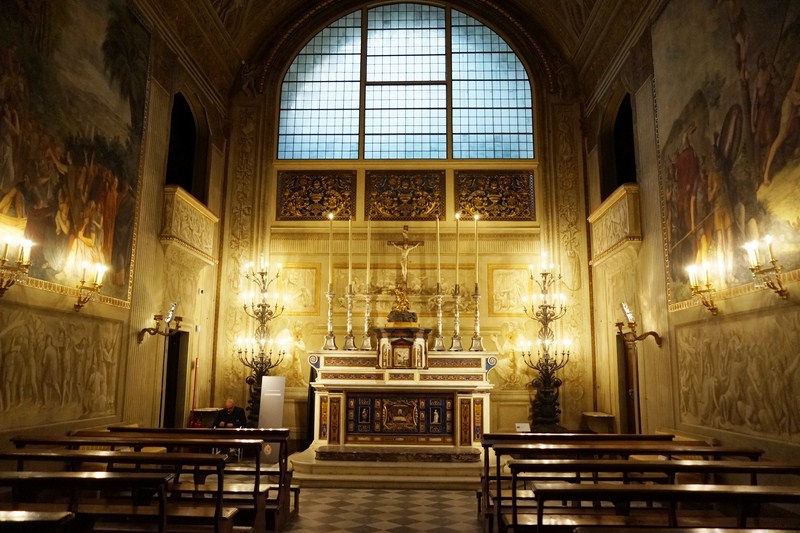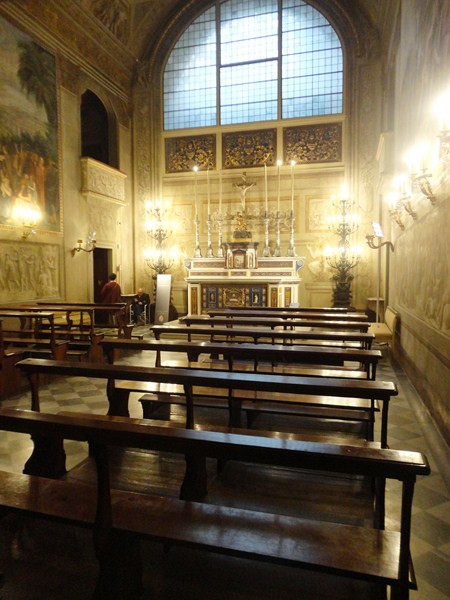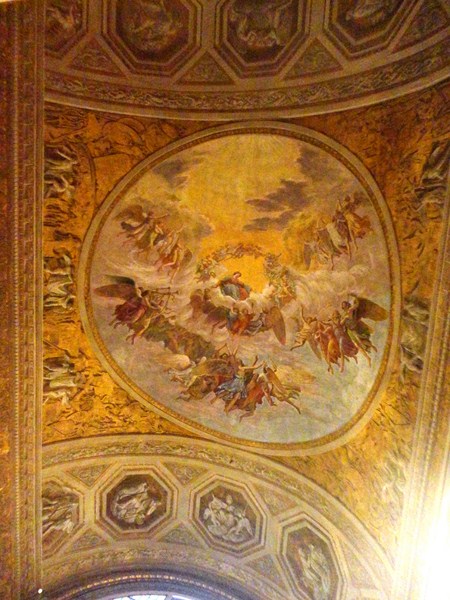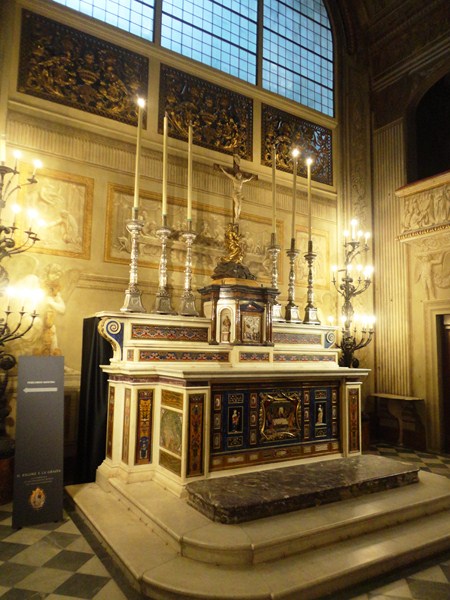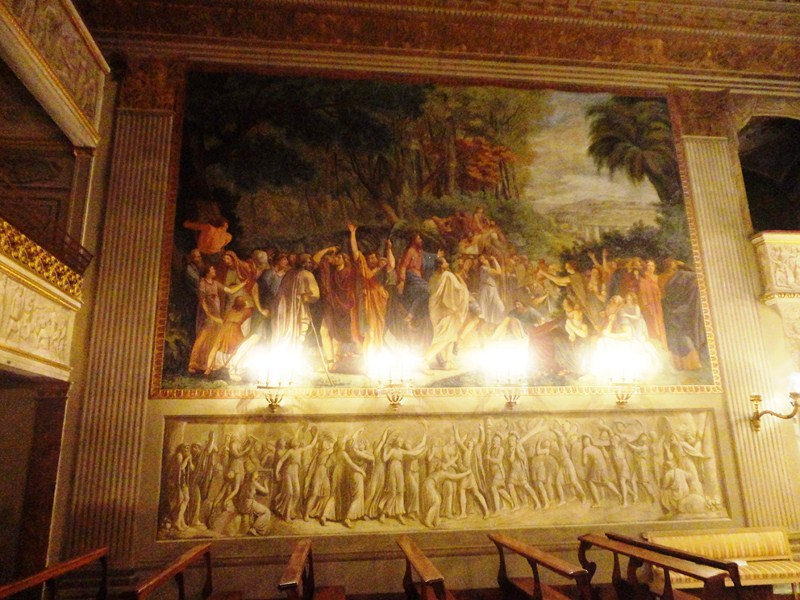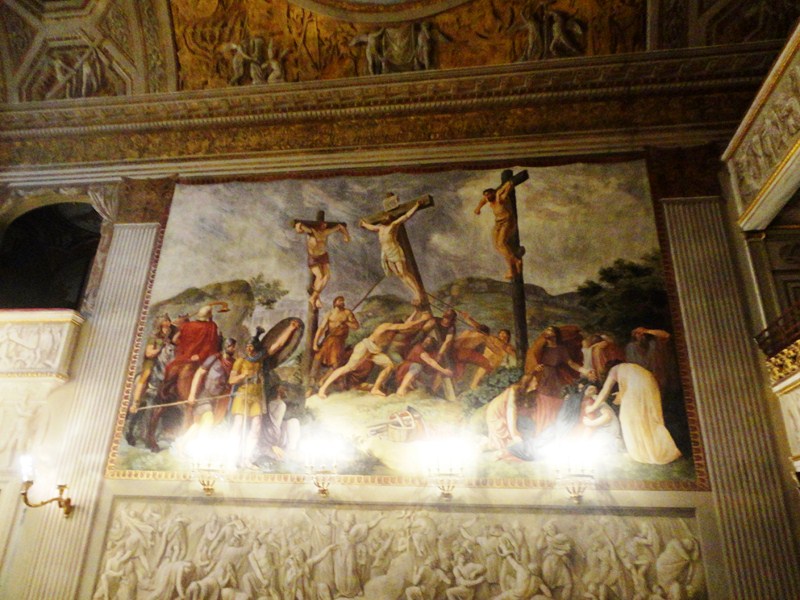The Palatine Chapel, completed in 1575, was originally a large environment forming part of the suites used as dining rooms that Bartolomeo Ammannati created on the ground floor of the Pitti Palace. Later, it was used firstly as a reception room and enhanced by precious vestments. In 1658, it was used as a lounge for the foreign princes and, in 1661, when Cosimo III married Marguerite Louise d’Orléans, the suite was renovated and used as a residence for the “Wedded Royals.”
For this occasion, Jacopo Chiavistelli decorated the rooms with frescoes featuring subjects and architectures we can only imagine today. According to the descriptions of the time, they portrayed Cosimo’s challenge and Apollo’s cart, among allegories of Day and Night on the vault, the months of the year and the Zodiac signs, alternating with backgrounds of architecture on the main walls and, on the smaller walls, the weapons of the Medici and the Orleans family.
In 1765, following the arrival of Grand Duke Leopold II of Lorraine in Florence, the area was radically transformed. Deciding to convert the hall into a new palace chapel, Leopold II assigned the renovation project to architects Ruggeri and Paoletti. They created stages for the court and musicians, opened up the great arched window that replaced the original ones and added choirs to the opposite side.
To the right of the altar, a small choir for the rulers was built while, on the wall behind the altar, a space for hosting ladies was carved out. Finally, the iconographic content of Chiavistelli’s frescoes was changed, with a few retouches, by painter Vincenzo Meucci who transformed it from the profane to sacred.
Initially, in 1766, work commenced on three wooden altars designed for the Chapel. In 1785, the three wooden altars were replaced by a new large single altar designed by painter Santi Pacini and made using parts of the altar, commissioned by Ferdinando I de’ Medici in the 16th century and destined for the Cappella dei Principi in San Lorenzo, which was never finished (the altar, over time, became a true mine of precious material to use for new works). They included two very interesting panels in bas-relief, attributed to Ludovico Cigoli, which were created using the semi-precious stone mosaic technique that dates to the early 17th century.
The first one, constituting the door of the ciborium above, represents “The Adoration of the Magi.” The second one, depicting “The Last Supper,” is positioned in the center of the frontal with allegories of Faith and Charity at the sides. It is flanked by full-relief figures, in niches, of the saints Athanasius and Giovanni Grisostomo. Both panels, set in splendid frames of white marble and golden bronze, feature jaspers, pearls, chalcedonies, quartz, amethysts and lapis lazuli. The precious ivory Crucifix with the figure of Magdalene at the feet of Christ, a masterpiece of Baroque eburnean sculpture, was left at the top of the new altar. Today, Lorenz Rues is credited with carving it and Antonio Raggi with creating the figure of Magdalene.
The altar, one of the most precious treasures contained in the Pitti Palace, was definitely created under the direction of Cosimo Siriès (then Superintendent of the Opificio delle Pietre Dure), who was also an artist. He further decorated the altar with holy ornaments in silver (a so-called “residence” with a cross, statues of saints and candlesticks). Unfortunately, all traces of the holy silver elements were lost during the French dominion. However, to this day, the silver and gold wooden ‘baldachin,’ added in 1793, still stands in the same spot.
The choirs were enhanced by adding two columns of alabaster from Montalcino. The two central doors of the main walls were closed to make space for the new fresco decorations created by Luigi Ademollo. Ademollo also painted the frescoes on the vault and the decorations on the choirs and small choirs, portraying “various events in the life of Jesus Christ’s” with strikingly scenographic characteristics (the “Crucifixion” on the wall to the right of the altar and “Palm Sunday” on the wall to the left). When Ferdinand III returned to Florence, Ademollo completed the decoration of the Chapel by decorating the left-hand choir in the chapel, built in 1823.
Between 1791 and 1792, Ferdinand III (who succeeded Leopold II) completely changed the decorative layout of the chapel in an operation that endowed the chapel with its current shapes, based on the design by Bernardo Fallani.
Although dating back to the mid 19th century, the ensemble picks up on the designs and motifs in use in the previous century, establishing a seamless dialog with the articulate decorations in white stucco and gold (carried out between 1685 and 1687 from designs by Giovan Battista Foggini), with scrolls and mottoes referring to Ferdinando and his wife, Violante di Baviera.
Palatine Chapel: Ground Floor, Pitti Palace, Piazza de’ Pitti, 1, Florence, Italy. Tel:+39 055 294883. Open Tuesdays-Sundays, 8:15 AM – 6:50 PM. Admission: Palatine Gallery (€8.50), Silver Museum (€6.00), Gallery of Modern Art (€8.50), Costume Gallery/Porcelain Museum/Boboli Gardens/Bardini Garden (€6.00).
How to Get There: Take the C3 or D bus to the Pitti stop.

